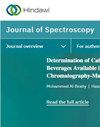利用光纤傅里叶变换近红外光谱原位分析番茄植株和细胞壁成分
IF 2.1
4区 化学
Q4 BIOCHEMICAL RESEARCH METHODS
引用次数: 0
摘要
本研究利用光纤傅里叶变换近红外光谱(FT-NIR)技术,对8个不同品种番茄植物叶片、花、果实、茎和细胞壁的原位化学特征进行了定位和解释。番茄的叶、花、果实和茎的化学光谱特征仅在其阶段和活模式下获得,如细胞壁颜色的绿色、黄色和红色。利用FT-NIR光谱的化学计量数据建模,对每个番茄植株进行光谱特征分析,以发现化学成分的实质性差异。此外,采用主成分分析(PCA)对同一品种的叶、花、果、茎进行区分。用主成分分析法对8个不同品种的番茄植株进行了鉴别。研究表明原位FT-NIR可以区分8种类型的番茄叶片、花、果实和茎在不同发育阶段与细胞壁和其他属性相关的化学成分。这项研究还证明了原位FT-NIR如何区分生锈的叶片与健康的叶片,以及完整的果实与离株的果实。本研究的主要目的是揭示活番茄和发育番茄的化学特征差异,以改善番茄的关键因素,从而有利于植物育种,番茄细胞壁研究,最终促进人类健康。本文章由计算机程序翻译,如有差异,请以英文原文为准。
In Situ Compositional Analysis of Tomato Plants and Cell Wall Using Fiber Optic Fourier-Transform Near-Infrared Spectroscopy
This research was intended to define and interpret cell wall attributes and other chemical composition of eight different varieties of tomato plants by utilizing fiber optic Fourier-transform near-infrared spectroscopy (FT-NIR) to acquire in situ chemical signatures of leaf, flower, fruit, and stem of tomato plant and cell wall at different developmental stages. Chemical spectral signatures of the tomato’s leaf, flower, fruit, and stem were only acquired during its session and in live mode such as green, yellow, and red in cell wall color. The spectral signature analysis of each tomato plant was performed to see substantial differences in chemical compositions using chemometric data modeling of FT-NIR spectra. In addition, principal component analysis (PCA) was performed to discriminate leaf, flower, fruit, and stem from the same variety. PCA was also performed to differentiate eight different varieties of tomato plants. The study showed how in situ FT-NIR could distinguish eight types of tomato leaf, flower, fruit, and stem chemical composition at different developmental stages related to cell wall and other attributes. This study has also demonstrated how in situ FT-NIR can discriminate between rusty vs. healthy leaf and intact fruit vs. off-the-plant fruit. The main objective of this study is to present the chemical signature differences in the live and developing tomato plants to improve crucial factors of tomatoes that would benefit plant breeding, tomato cell wall study, and ultimately human health.
求助全文
通过发布文献求助,成功后即可免费获取论文全文。
去求助
来源期刊

Journal of Spectroscopy
BIOCHEMICAL RESEARCH METHODS-SPECTROSCOPY
CiteScore
3.00
自引率
0.00%
发文量
37
审稿时长
15 weeks
期刊介绍:
Journal of Spectroscopy (formerly titled Spectroscopy: An International Journal) is a peer-reviewed, open access journal that publishes original research articles as well as review articles in all areas of spectroscopy.
 求助内容:
求助内容: 应助结果提醒方式:
应助结果提醒方式:


